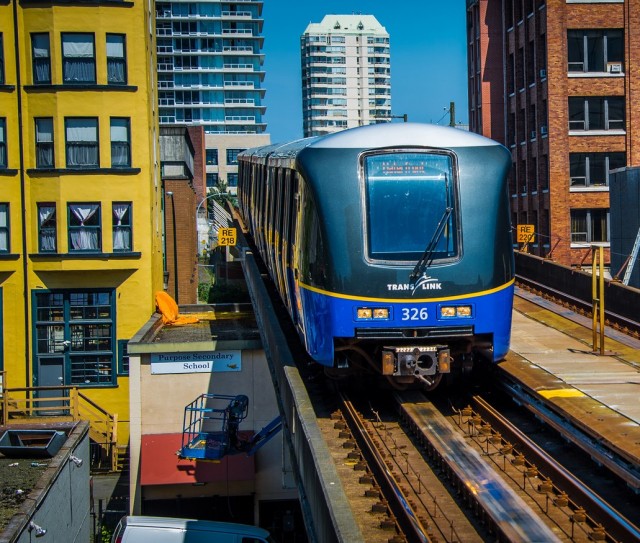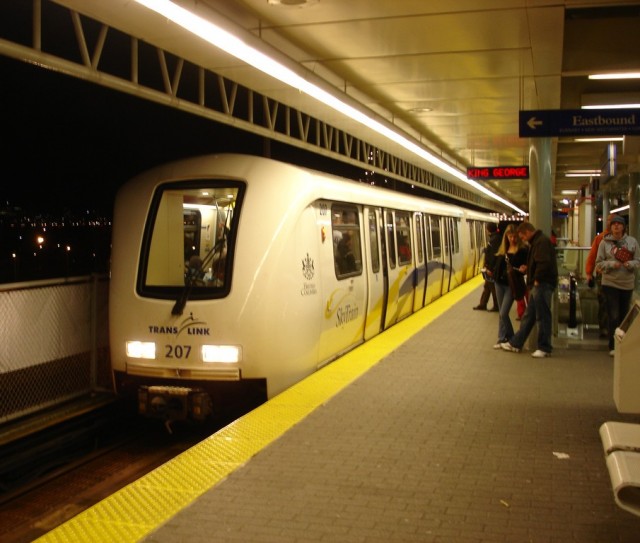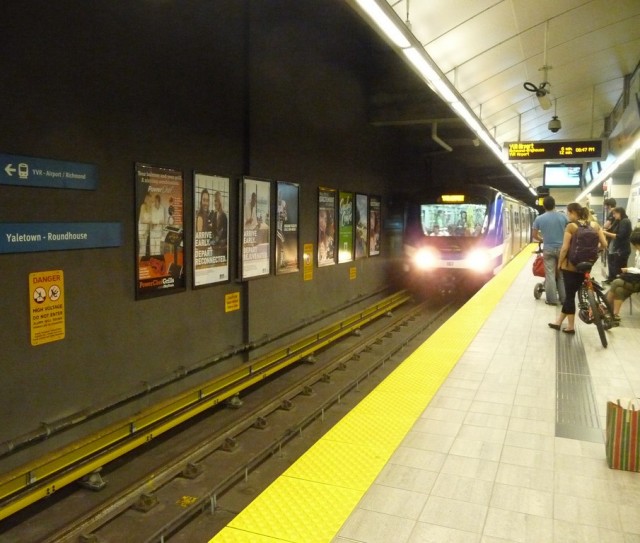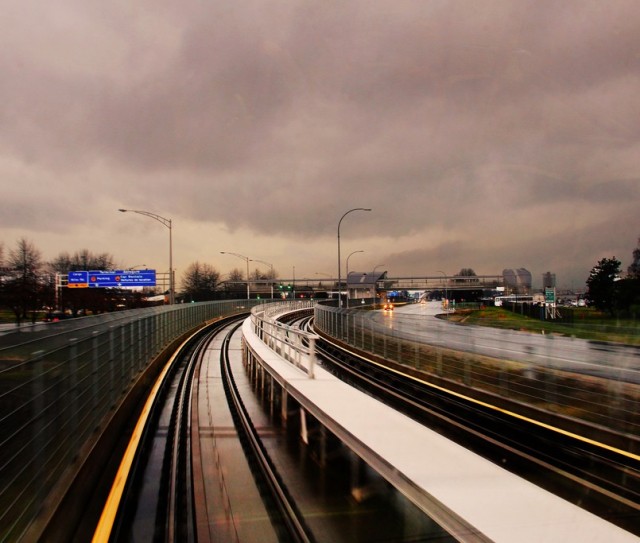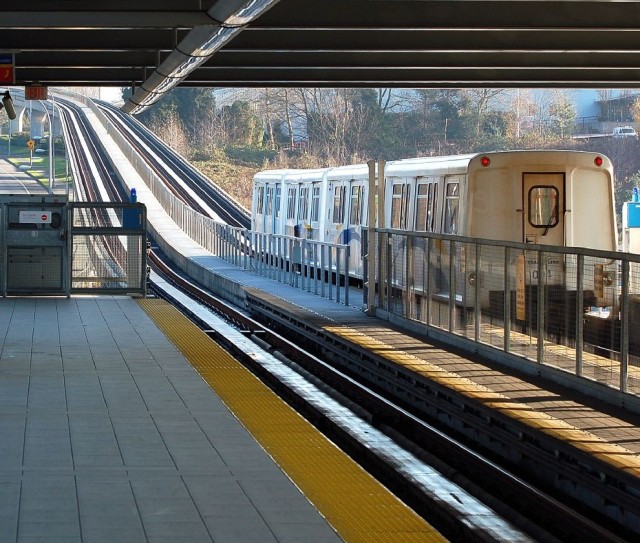Info
The Vancouver Metro, known for its original name "SkyTrain," holds the distinction of being the world's largest automated subway system and Canada's most recent subway, inaugurated in 1986. This unique transportation network comprises three light metro lines constructed above ground on elevated overpasses, setting it apart from traditional subway systems. The SkyTrain's nomenclature is both distinctive and meaningful. Each line was opened to commemorate significant events in Vancouver's history. The Expo Line, launched to coincide with the World Exhibition in Vancouver, the Millennium Line, inaugurated in celebration of the new millennium, and the Canada Line, named in honor of the 2010 Winter Olympics held in Vancouver.
Although relatively young and continually expanding, the Vancouver SkyTrain plays a pivotal role in the daily lives of residents and visitors alike. It primarily serves passengers commuting from the city center to outlying areas and neighboring cities, including Richmond, Burnaby, and Coquitlam. Impressively, it caters to around four hundred thousand passengers daily.
The central hub of Metro Vancouver's transportation network is the Waterfront Station, which houses terminals for commuter trains and the SeaBus ferry service. Additionally, the SkyTrain provides convenient access to Vancouver's Pacific Central train station, Vancouver International Airport, and several prominent attractions, such as Science World, Queen Elizabeth Park, and VanDusen Botanical Garden. The SkyTrain system falls under the purview of TransLink, the regional transportation authority responsible for managing various modes of public transit, including buses, ferries, and commuter trains. This integrated approach ensures passengers can access a unified ticketing system, simplifying their travel experience. Metro Vancouver's transportation network is divided into three zones, with ticket prices contingent on the number of zones crossed during the journey. Fares range from 3.15 CAD for a single zone to 6.20 CAD for traveling through three zones. Passengers traveling from the airport area incur an additional 5.00 CAD fee, which is added to the overall fare. It's essential to note that traveling without a valid ticket on public transport in Vancouver results in a significant fine of 173 CAD.
Due to their elevated positioning, Vancouver's SkyTrain stations are generally straightforward and consist of two platforms sheltered by canopies on either side of the track. The SkyTrain trains themselves are monorail and operate without onboard personnel. They typically consist of two or four cars, providing efficient and autonomous transportation.
The Vancouver metro system is relatively young and not yet very developed. The Vancouver skytrain is mainly used by passengers to get from the city center to its remote areas and neighboring cities: Richmond, Burnaby, Coquitlam. About four hundred thousand people use the Vancouver metro services every day. Metro Vancouver's main station is Waterfront Station, where the commuter train and SeaBus ferry terminals are located. You can also take the subway to Vancouver's Pacific Central train station, Vancouver International Airport, and some attractions: Science World, Queen Elizabeth Park, and VanDusen Botanical Garden.
The Vancouver Metro is part of the city's public transport system and is operated by TransLink, which also operates buses, ferries and commuter trains. Thanks to this, in Vancouver there is a single ticket for all types of public transport. Vancouver's transport network is divided into three zones. The price of a metro or bus ticket depends on the number of zones crossed by the passenger - 3.15 CAD for one zone, 4.55 CAD for two, 6.20 CAD for three zones. For passengers traveling from the airport area, a special fare of 5.00 CAD is applied, which is added to the total cost of the trip. The fine for traveling without a ticket on public transport in Vancouver is 173 CAD. Due to their elevated location, Vancouver metro stations are unremarkable and for the most part consist of two platforms located under canopies on either side of the track. Vancouver's Skytrain trains are monorail, unmanned, and usually consist of two or four cars.
Lines
The Vancouver Metro, also known as SkyTrain, is comprised of three primary lines: the Expo Line, Millennium Line, and Canada Line, serving a total of 47 stations. This extensive network offers commuters and travelers an efficient means of navigating Vancouver's city center, reaching outlying areas, and providing a convenient connection to the airport.
Operating hours for the Vancouver Metro are generally between 5:00 AM and 1:30 AM. However, it's important to note that on weekends, there is a modified schedule in place. The Expo and Millennium lines commence service on Saturdays at 6:00 AM and on Sundays and holidays at 7:00 AM. These schedules ensure that residents and visitors alike have reliable access to public transportation throughout the week.
Fare
Metro Vancouver operates a fare system that adapts to the number of zones crossed, offering flexibility and convenience for passengers. Travel within a single zone costs 3.15 CAD for a one-time ticket. For trips spanning two zones, the fare is 4.55 CAD. Travel covering all three zones incurs a fare of 6.20 CAD. After 18:30 on weekdays, as well as on weekends and public holidays, a flat rate of 3.15 CAD applies for all zones. All single tickets, regardless of the number of zones crossed, are valid for 90 minutes from the moment of validation.
If you're traveling from the Airport zone, there's an additional 5.00 CAD charge, while travel within this specific zone is complimentary with a designated ticket.
For unlimited travel within Metro Vancouver, the DayPass is available for 11.25 CAD, allowing unlimited rides on the subway, bus, and ferry throughout the day. Monthly passes offer extended savings: a monthly pass for 1 zone is priced at 104.90 CAD, for 2 zones, the monthly pass costs 140.25 CAD. For access to all 3 zones, the monthly pass is available for 189.45 CAD.
Notably, children under 12 years old can enjoy free access to Vancouver public transportation, including the SkyTrain, buses, and ferries, making it a family-friendly and cost-effective choice for travel.
Ticketing
Traveling within Vancouver Skytrain is made convenient and efficient with various contactless payment options. You can easily pay for your fares using any contactless method, such as a bank card or a mobile phone equipped with contactless payment functionality. Here's how it works. Entering the System: To begin your journey, simply present your bank card or mobile phone to the reader located at the turnstile in the subway or the validator on buses. Traveling: As you make your way through the system, the system will automatically record your entry, and your fare will be determined based on the zones you travel through. Exiting the System: When you reach your destination and exit the station, once again, present your card or phone to the reader at the turnstile. The system will calculate your fare and deduct it from your account.
For those who prefer more traditional fare methods, travel tickets and reloadable Compass Cards are available for purchase at vending machines located at various stations.
 English
English Deutsch
Deutsch Français
Français Italiano
Italiano Español
Español Português
Português Русский
Русский Українська
Українська Polski
Polski Čeština
Čeština Ελληνικά
Ελληνικά Türkçe
Türkçe Tiếng Việt
Tiếng Việt ไทย
ไทย 日本語
日本語 中文
中文 한국어
한국어